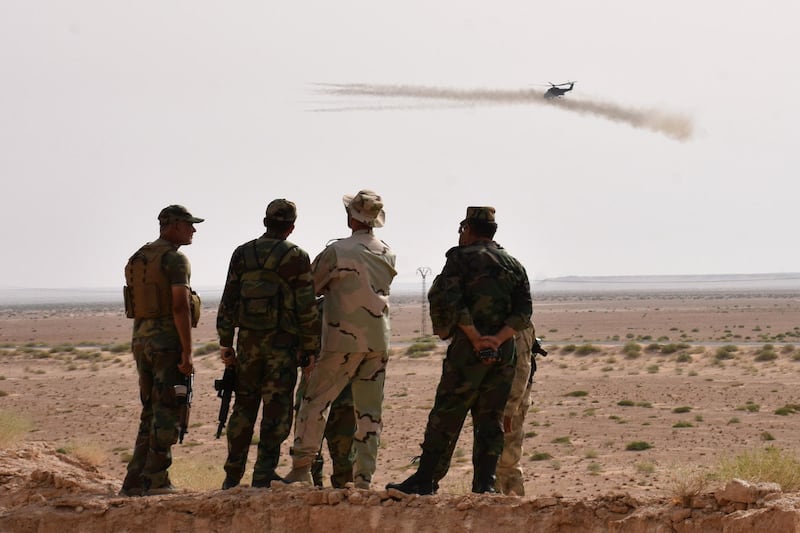The map of the Syrian war looks increasing tidy. The Syrian regime is steadily securing and expanding its areas of influence. Forces backed by the United States-led coalition are swallowing ISIL-held territory in much of eastern Syria and have, in the process, controlled a viable region instead of small enclaves.
The opposition's territorial and political influence has shrunk significantly, but its remaining enclaves might become defined along clear lines in the next year. Rebel factions are facing pressure from both their own allies and reenergised loyalist forces to recede or to cease military activities against the regime. The US and Jordan recently fell out with three of the main factions leading the charge against the regime and ISIL in the Syrian desert. Al Qaeda's off-shoot, Hayat Tahrir Al Sham, is gradually eliminating rivalry and taking over the rebel stronghold in Idlib.
The Syrian opposition is unlikely to overcome jihadi and Islamist dominance and it thus has increasingly little chance to gain international defenders for a greater role. Regional and international backers see a political solution exclusively through the Geneva process, a sequence appended by the Russia-sponsored Astana process, based on ceasefires agreed by Ankara, Tehran and Moscow.
_______________________
Read more
[ Syrian troops breach 3-year ISIL siege on Deir Ezzor ]
[ US blames Syrian regime as ISIL convoy remains stranded for seventh day ]
_______________________
The opposition’s value is determined largely by how useful it can be as a force against religious extremists, as its original goals of deep political change are abandoned by its backers. This counterterrorism-based determination is made by its supporters as well as its critics. Its supporters maintain that extremists cannot be defeated without a solution acceptable to the forces that rose up against the regime; its critics say that the opposition’s value is diminished by its inability to eject extremists in its midst.
The emerging trend on the map will possibly continue. Both Russia and the US have their eyes set on Deir Ezzor to expel ISIL from its last major strongholds in the country – after the group is defeated in Raqqa. This week, the regime broke a three-year siege around a tenacious garrison that survived five years of repeated onslaughts by the rebels, Al Qaeda and ISIL. If the current thinking in Washington prevails, the rest of the province will also be liberated by the US-backed Syrian Democratic Forces.
Regardless of the expected length of the Deir Ezzor battle, once it is determined who handles what part of the eastern province, the conflict map will arguably begin to have a lasting form.
To be sure, the situation will not be completely static. The regime might recapture some of what it views as vital areas around its strongholds in the north west and near the capital. But, aside from small potential changes, it is now possible to imagine a way forward for the Syrian conflict.
In this context, this is a time for the big players to invest seriously in a political solution rather than to give in to the idea that Bashar Al Assad is winning. While Mr Al Assad's fate now seems stable, that is not the same as the regime is about to settle the war's outcome. The current military situation provides an opening for a political offensive. Such a political push could be made easier by two new dynamics.
First, the US is now a player with a huge leverage on the ground that it did not have three years ago. Washington's previous engagement with the opposition, notwithstanding its seriousness, failed to produce results in the way of stability. Today, the US is present inside Syria and a sustained commitment is necessary to keep ISIL and other jihadist groups in check.
Second, ragtag militias do not dominate areas liberated from ISIL as was the case prior to the summer of 2014. The US-led coalition could benefit from what can be described as the “cleaning powder effect”: when ISIL takes over an area, one of its top priorities is to cleanse the area from any Islamist or jihadist rivals and cells. Once such an area is liberated from ISIL, the liberators have a “clean slate” in which they could operate.
_______________________
More on ISIL and Al Qaeda in Opinion
[ ISIL is proving a useful tool in advancing diverging agendas in Syria ]
[ 'The State' drama series on ISIL is anything but apologetic ]
[ Is there ever an appropriate occasion to negotiate with terror groups? ]
[ The story of Hayat Tahrir Al Sham's rise to prominence and what it means for Syria ]
_______________________
It will be up to the international coalition to shape the local communities now free from ISIL and ensure jiahdists fail to rebuild their networks. Al Qaeda, for example, has to build its influence almost from scratch in areas from which ISIL expelled it. It will have to do so even in places where it had previously strong local presence, such as in Deir Ezzor. Its success or failure will be contingent on what comes after ISIL and whether locals continue to see their new rulers as liberators.
As the map of the Syrian war changed over the past three years, so did the nature of outsiders' involvement. The US has the leverage and assets to have a say in the conflict and, at the same time, it has no choice but to stay if it is to see through the real erosion of the ISIL threat. A prudent use of this leverage will be to ensure not only that ISIL does not return but also that the US does not come back again to deal with a conflict it previously shunned.
One mistake outsider observers make is to look at the changing military map and conclude that because the regime is steadily gaining and because the opposition’s original political objectives are impossible to achieve, the matter will be settled in favour of the regime. This would only undo any temporary success achieved over the past three years. The changing military reality in Syria merely provides a renewed window of opportunity to steer the country towards stability.
Hassan Hassan is a senior fellow at the Tahrir Institute for Middle East Policy
Follow The National's Opinion section on Twitter





